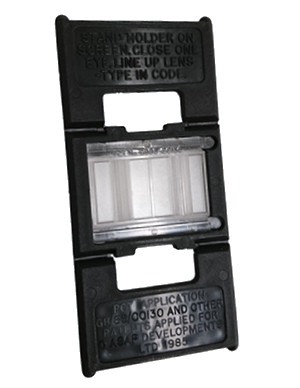Lenslok Software Protection Device
| Home > Browse Our Collection > Peripherals > Copy Protection Devices > Lenslok Software Protection Device |
|
In the 1980s, many different ways of preventing software piracy had been tried, from fast loaders that made tape to tape copying more difficult, but at the expense of reliability, to colour code charts.
Lenslock was definitely the most elaborate, but also easily the most controversial.
It was the invention of John Frost, who took it to ASAP Developments who brought it to market.
Lenslock, is a piece of plastic and a small piece of front end software that was designed to completely prevent the piracy of software.
The idea being if you did not own one, and somebody were to give you a pirated copy of the game it was attached to, it
would be impossible to get into that game.
The Lenslok device was rectangular with prisms in the centre and was used in two steps.
The game and Lenslok code would be loaded, then the device was held flat on to the TV screen,
then lines would have to be drawn inwards with the cursor keys to match
the length of the device on screen, the Lenslok would be folded into a C
shape.
Keys were then pressed until the letters OK could be seen clearly
through it.
If this was completed successfully, another code would have to be read and then the game would start.
Often though it was very fussy indeed, and if it deemed the
user had got it wrong the memory would be cleared.
Another problem was the device not being terribly durable, it would not be uncommon for one of the end pieces to break off.
What made the device so much worse was that anyone using a portable
TV would find the Lenslok even harder to use, as the letters were more difficult to see, or the lines in the program could not be made small
enough.
Notable software companies that used the device were BT Telecom subsidiaries such as Rainbird and Firebird, Cascade, Level 9 and also Digital Integration. The uptake was not high for the device, mainly due to the added cost of adding the software, and then including the device with every different game that used it.
All the Lenslok devices were different for the games and companies
that used them, so an Elite one would not work on a Digital Integration
game. The Device was so unpopular that when it was found the 48K version
of ZX Spectrum Elite did not run on the new 128K machine, the Lenslok part of
the program was removed for the patched version, even though it had nothing to do with the game not working.
There was also an interface for the home computers released by Romantic Robot called the Multiface, which could alter code and enter cheats into games. But it was also able to take a game loaded into memory, and re write it to tape at the point the red button on top was pressed, this meant that the game could be loaded, the painful Lenslok procedure endured once, then the program saved past the Lenslok program.
The software titles that used Lenslok were:
Ace, Cascade
Elite, Firebird
Fighter Pilot, Digital Integration
Jewels of Darkness, Level 9
OCP Art Studio, Rainbird
The Price of Magik, Level 9
Silicon Dreams, Level 9
Supercharge, Digital Precision
Tomahawk, Digital Integration
TT Racer Digital Integration
Due to the sheer amount of sales Of Spectrum Elite, it become synonymous with the device.
All a classic case of punishing the legitimate user who were actually spending the money on the software.
Manufacturer : ASAP Developments Physical Description : Plastic piece This exhibit has a reference ID of CH56946. Please quote this reference ID in any communication with the Centre for Computing History. |
|










